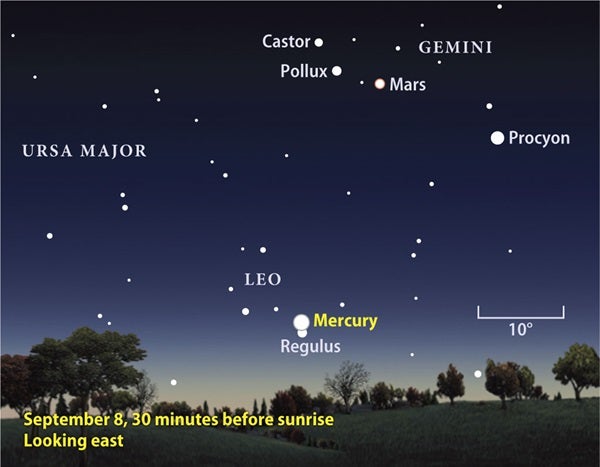The solar system’s smallest planet makes its best morning appearance of 2011 in early September. Often obscured by the Sun, Mercury appears brightest before dawn on the 3rd, providing a great view to anyone using a telescope, binoculars, or even naked eyes.
The morning of September 1, Mercury stands 4° above the eastern horizon an hour before sunrise and climbs to 10° within 30 minutes. It then gradually brightens the next 2 days until its peak on the 3rd, when it lies 18° west of the Sun and shines at magnitude –0.3. “If you’re a fan of Mercury, this is what you’ve been waiting for,” said Astronomy Senior Editor Michael E. Bakich. “Soon, the Sun’s glare will wash out the tiny planet once again, so now’s the time to check it out.”
To locate the planet later in the month, scan the twilight sky for 1st-magnitude Regulus, about one binocular field of view below Mercury, in Leo the Lion. After slowly approaching the star, Mercury lies 1.3° above Regulus on September 8, outshining the star by a factor of 8. Over the following week, Leo appears to glide up past Mercury as the planet drops back into the Sun’s glare. Mercury eventually dips behind the Sun, in an event called superior conjunction, September 28.
“September’s first two weeks are also a great time to target Mercury through a telescope,” said Bakich, “because its appearance will change rapidly and dramatically. On the 1st, its disk is 8″ across and barely one-third lit, but by the 14th it’ll span just 6″ while waxing to 86 percent illumination. In other words, it’ll look great!”
Fast facts
- Mercury orbits the Sun closer than any other planet, at an average distance of 36 million miles (58 million kilometers).
- With a diameter of 3,032 miles (4,880 km), or 38 percent that of Earth, Mercury is the smallest planet in the solar system.
- Mercury takes just 88 days to complete one orbit of the Sun, making it the fastest planet in the solar system.
- This speed doesn’t extend everywhere, though, as Mercury takes 59 days to rotate once on its axis.
- The name Mercury comes from the Romans’ messenger god, renowned for his swiftness.
- Humans got their first close look at Mercury in March 1974 when NASA’s Mariner 10 spacecraft flew by and revealed a heavily cratered surface.
- NASA’s MESSENGER (MErcury Surface, Space ENvironment, GEochemistry and Ranging) spacecraft, launched in 2004, has already flown by Mercury three times and is the first probe to orbit the planet.
- StarDome: Locate Mercury in your early morning sky with our interactive star chart.
- Sign up for our free weekly e-mail newsletter.
- Get daily observing highlights, including ones about Mercury, in The Sky this Week.











